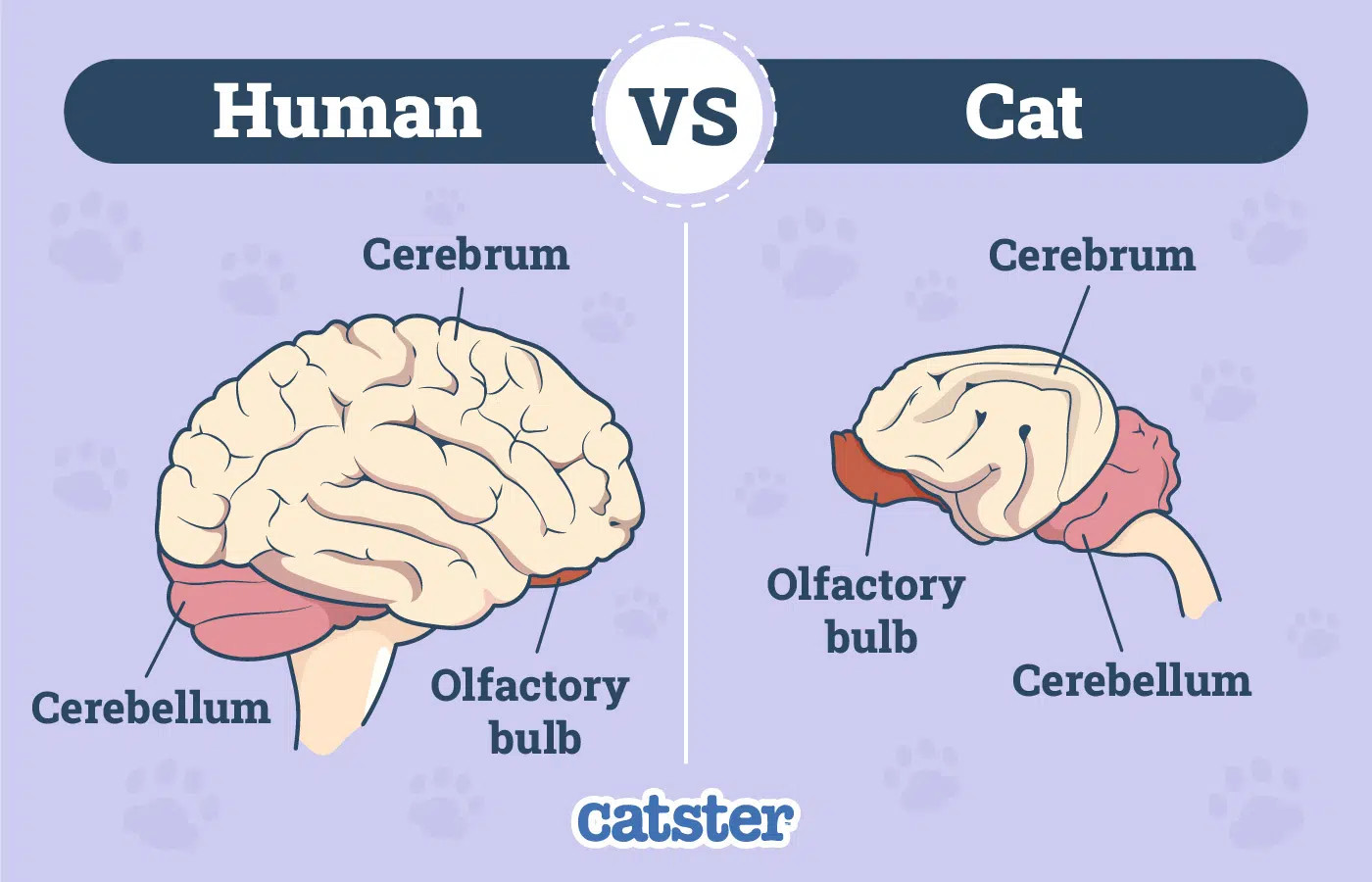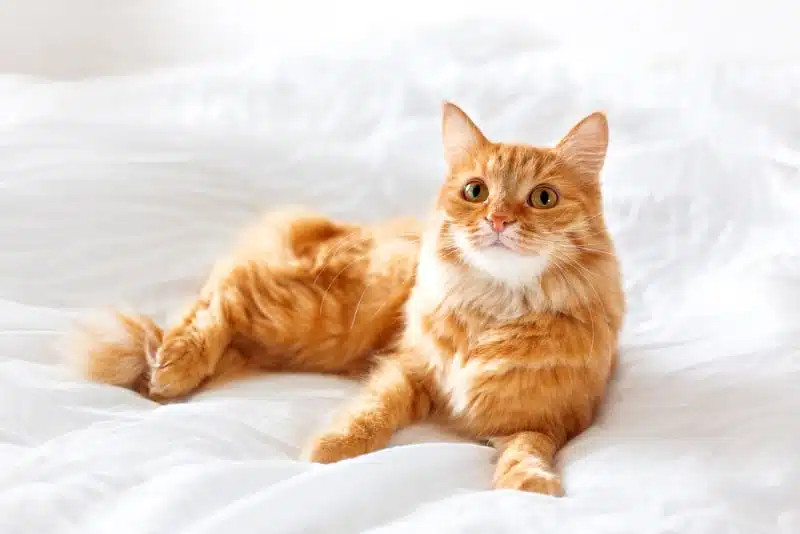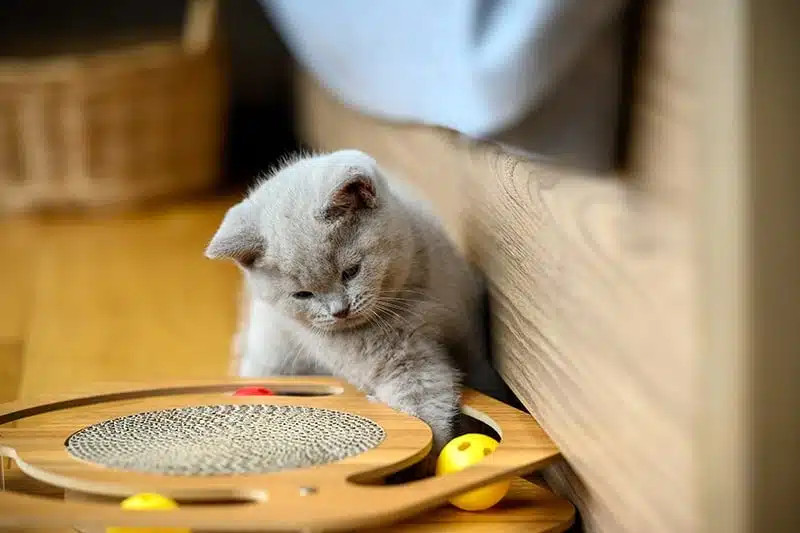How big is a cat brain? Your cat’s brain, though small, is a powerhouse of sensory perception and instinct. At solcat.net, we help you understand your feline friend’s behavior and cognitive abilities, ensuring a happier, healthier life for your cat. Dive in to discover feline intelligence, cat brain size, and more fascinating feline facts.
1. What is the size of a cat’s brain compared to other animals?
A cat’s brain weighs about one ounce and is roughly 2 inches long, representing approximately 1% of their body weight. Compared to a dog’s brain, which is about the size of a tangerine, a cat’s brain is similar in size to a walnut. While size isn’t the sole determinant of intelligence, it’s interesting to note that cats have a brain structure more similar to humans than dogs do. This unique structure allows them to process information and interact with their environment in ways that are both fascinating and distinctly feline.
Despite being smaller than a dog’s brain, the feline brain is surprisingly complex. The surface folding and specific structures within the brain play a more significant role in determining intelligence than overall size. Cats possess around 300 million neurons in their cerebral cortex. Their brains are wired for movement and vision, which explains their agility and hunting prowess. Visit solcat.net for more insights into your cat’s unique abilities and how they use their brain to navigate the world.
 Cat Brain vs Human Brain
Cat Brain vs Human Brain
2. How does a cat’s brain structure compare to a human’s brain structure?
Cats have a brain structure that is about 90% identical to humans. Despite having fewer neurons in their cerebral cortex (around 300 million compared to our 21 to 26 billion), the structural similarities are remarkable. These similarities influence how cats process information, experience emotions, and interact with their surroundings, mirroring human-like cognitive functions to a surprising degree.
The high degree of similarity in brain structure explains why cats exhibit complex behaviors and emotions that resonate with human experiences. It’s why they can form strong bonds with their owners, display empathy, and even learn tricks. Understanding these similarities can help you better connect with your feline companion and appreciate their intelligence. Explore solcat.net for more articles on cat behavior, training tips, and ways to enrich your cat’s life.
3. What is the number of neurons in a cat’s brain versus a dog’s brain?
Dogs generally have more neurons than cats, which is largely attributed to their larger brain size. While cats have around 300 million neurons in their cerebral cortex, dogs tend to have a higher neuron count. This difference in neuron density can influence cognitive abilities and behavior patterns. In dogs, a larger portion of the cerebral cortex is dedicated to social cognition, while in cats, it’s more focused on movement and vision.
This neurological distinction explains why dogs are often perceived as more social and trainable, whereas cats are renowned for their agility and hunting skills. Understanding these differences can help owners tailor their interaction and training methods to better suit their pet’s natural abilities. At solcat.net, we offer insights and advice on how to nurture your cat’s unique talents and cater to their specific needs.
4. How does a cat’s brain regulate its daily life and behaviors?
A cat’s brain governs every aspect of its life, including their crepuscular nature, which means they are most active during dawn and twilight hours. This behavior is hardwired into their brains, driving them to hunt when their prey is also most active. This instinctual behavior is crucial for their survival, influencing their hunting habits even when they are well-fed.
Understanding your cat’s crepuscular nature can help you better manage their activity levels and ensure they have appropriate outlets for their energy. Providing toys and playtime during these peak activity times can help prevent unwanted behaviors, such as waking you up in the pre-dawn hours. Check out solcat.net for tips on creating an enriching environment for your cat and understanding their natural instincts.
 orange cat lying on bed
orange cat lying on bed
5. How do cats use their five senses with their brains?
Cats use their brains to uniquely process sensory information, allowing them to navigate and thrive in their environment. Each of their five senses—sight, taste, hearing, touch, and smell—is intricately linked to their brain, enabling them to perceive the world in a way that is perfectly tailored to their needs as predators and survivors.
5.1. Sight
Cats possess exceptional vision, especially in low-light conditions, thanks to a structure called the tapetum lucidum in their eyes. This reflective layer enhances their ability to see in the dark by reflecting light back onto the retina. They also have more rods in their eyes, which are photoreceptor cells that function best in dim light, further improving their night vision.
5.2. Taste
Cats have fewer taste buds compared to humans, and they cannot taste sweetness. Their taste preferences are geared towards detecting fats and bitter flavors, the latter of which helps them identify potentially harmful substances. This unique taste profile influences their dietary preferences and eating habits.
5.3. Hearing
Cats have acute hearing capabilities, aided by their cone-shaped pinnae (outer ears), which help direct sound into the middle ear. This allows them to pinpoint the exact location of sounds, making them excellent hunters. Their hearing is so precise that they can detect the slightest movements of prey, even in complex environments.
5.4. Touch
Cats use touch to navigate their surroundings, relying on their whiskers to sense changes in their environment. Their whiskers provide tactile information, helping them move through narrow spaces. They also have touch receptors in their paws and nose, enhancing their sensitivity to textures and pressure.
5.5. Smell
Cats heavily depend on their sense of smell, which is crucial for detecting food and identifying other cats. They also have a vomeronasal organ, located in their mouth, which allows them to process pheromones. Pheromones play a vital role in feline communication, influencing social behaviors and mating rituals.
By understanding how cats use their senses, you can better appreciate their unique perspective and provide an environment that caters to their sensory needs. Visit solcat.net for more information on cat behavior and sensory enrichment tips.
6. What are the main parts of a cat’s brain and their functions?
The central nervous system (CNS) in cats consists of the brain and the spinal cord. The major parts of the brain include the cerebellum, cerebrum, and brainstem, each playing a critical role in feline behavior and physiology.
6.1. Cerebellum
The cerebellum is primarily responsible for motor control, coordination, and balance. This part of the brain allows cats to perform complex movements with precision and agility. Damage to the cerebellum can result in difficulties with balance and coordination.
6.2. Cerebrum
The cerebrum is the largest part of the brain and is involved in higher-level cognitive functions such as learning, memory, and decision-making. It is also responsible for processing sensory information and initiating voluntary movements. The cerebrum enables cats to adapt to their environment and learn from their experiences.
6.3. Brainstem
The brainstem connects the brain to the spinal cord and regulates essential functions such as breathing, heart rate, and sleep-wake cycles. It also plays a role in controlling reflexes and transmitting sensory information. The brainstem is vital for maintaining basic life functions.
Understanding the functions of these brain regions can provide insights into your cat’s behavior and health. For example, changes in balance or coordination may indicate an issue with the cerebellum, while cognitive decline could be related to the cerebrum. For more detailed information about cat anatomy and health, visit solcat.net.
 Cat Brain Parts
Cat Brain Parts
7. Are cats becoming less intelligent over time?
Research suggests that domestic cats may have experienced a reduction in brain size compared to their wild ancestors. Studies indicate that house cats have undergone a roughly 25% decrease in brain size compared to European and African wildcats. This change is likely due to domestication and the reduced need for survival skills that wild cats require.
However, a smaller brain size does not necessarily equate to lower intelligence. Domestic cats have adapted to living in human environments, developing social skills and learning to communicate with their owners. While they may not need to hunt for food or defend themselves against predators, they exhibit complex behaviors and cognitive abilities that are well-suited to their domestic lives.
At solcat.net, we explore the fascinating world of feline intelligence and behavior, providing insights into how cats have evolved and adapted over time.
8. How does brain size affect a cat’s hunting abilities?
The brain size of a cat, while small, is efficiently wired to support their hunting abilities. Cats possess specialized sensory and motor skills that are crucial for hunting success. Their keen eyesight, acute hearing, and precise motor control, all governed by their brain, make them highly effective predators.
8.1. Vision
Cats have excellent vision, especially in low light, which is essential for hunting at dawn and dusk. Their ability to detect subtle movements and track prey is facilitated by the structure and function of their eyes and brain.
8.2. Hearing
A cat’s acute hearing allows them to detect the faintest sounds of potential prey, even when hidden from view. Their brain processes auditory information quickly and accurately, enabling them to pinpoint the location of their target.
8.3. Motor Control
The cerebellum plays a vital role in coordinating movement and balance, allowing cats to stalk, chase, and capture prey with precision. Their agility and reflexes are finely tuned to maximize their hunting success.
Despite having a smaller brain than some other animals, cats are highly skilled hunters, thanks to the specialized wiring of their brain and sensory organs. Visit solcat.net for more information on how cats use their brains to hunt and survive.
 british shorthair kitten playing with puzzle toy
british shorthair kitten playing with puzzle toy
9. What are the factors influencing a cat’s brain development and size?
Several factors influence a cat’s brain development and size, including genetics, nutrition, and environmental stimulation.
9.1. Genetics
Genetics play a significant role in determining the overall size and structure of a cat’s brain. Different breeds may have variations in brain size and cognitive abilities due to their genetic makeup.
9.2. Nutrition
Proper nutrition is essential for brain development, particularly during the kitten stage. A diet rich in essential nutrients, such as omega-3 fatty acids, supports healthy brain growth and cognitive function.
9.3. Environmental Stimulation
Providing a stimulating environment can promote brain development and cognitive abilities. Interactive toys, puzzles, and social interaction can help keep a cat’s brain active and engaged.
Understanding these factors can help cat owners provide the best possible care for their feline companions, supporting their brain health and cognitive function. At solcat.net, we offer advice on nutrition, enrichment, and other aspects of cat care.
10. How does a cat’s brain contribute to its unique behaviors?
A cat’s brain plays a crucial role in shaping its unique behaviors, from hunting and grooming to social interaction and play.
10.1. Hunting Behaviors
The brain drives hunting behaviors, from stalking and chasing to capturing prey. Instincts and reflexes are hardwired into their brains, making them efficient predators.
10.2. Grooming Behaviors
Grooming is an essential behavior for cats, helping them maintain hygiene and regulate body temperature. The brain controls grooming behaviors, ensuring they stay clean and healthy.
10.3. Social Behaviors
Cats exhibit a range of social behaviors, from forming bonds with humans and other animals to communicating through vocalizations and body language. The brain processes social cues and influences social interactions.
10.4. Play Behaviors
Play is an important part of a cat’s life, providing mental and physical stimulation. The brain drives play behaviors, encouraging them to explore their environment and engage in playful activities.
By understanding how a cat’s brain influences its behaviors, you can better appreciate its unique personality and provide an environment that meets its needs. Visit solcat.net for more insights into cat behavior and tips on how to create a happy and stimulating life for your feline friend.
Frequently Asked Questions (FAQ)
1. How does the size of a cat’s brain impact its trainability?
While a cat’s brain is smaller than a dog’s, it doesn’t necessarily hinder their trainability. Cats can be trained using positive reinforcement techniques, leveraging their natural instincts and intelligence.
2. Can a cat’s brain size indicate its level of affection?
No, a cat’s brain size does not directly correlate to its level of affection. Affection is more related to individual personality, experiences, and the bond with their human companions.
3. Do different breeds of cats have different brain sizes?
Yes, different breeds can have slight variations in brain size due to genetic factors. However, these differences are generally minor and do not significantly impact their overall intelligence or behavior.
4. How does diet affect a cat’s brain health?
A balanced diet rich in essential nutrients is crucial for maintaining a cat’s brain health. Omega-3 fatty acids, in particular, support cognitive function and can help prevent age-related decline.
5. Can environmental enrichment improve a cat’s brain function?
Yes, providing environmental enrichment, such as interactive toys and puzzle feeders, can stimulate a cat’s brain and improve cognitive function. These activities challenge their minds and keep them mentally engaged.
6. What are the signs of cognitive decline in cats?
Signs of cognitive decline in cats can include disorientation, changes in sleep patterns, decreased social interaction, and loss of learned behaviors.
7. Is it true that cats only use 10% of their brains?
No, the myth that humans or animals only use 10% of their brains is false. Cats use all parts of their brains, each responsible for different functions and processes.
8. How does stress impact a cat’s brain?
Chronic stress can have negative effects on a cat’s brain, leading to anxiety, behavioral changes, and even physical health problems. Providing a calm and stable environment is essential for their well-being.
9. Can cats recognize themselves in a mirror?
Most cats do not recognize themselves in a mirror. They typically react to their reflection as if it were another cat, indicating they do not possess self-awareness in that context.
10. How do cats use their brains to solve problems?
Cats use their brains to solve problems by relying on their memory, observation skills, and trial-and-error learning. They can figure out how to open doors, access food, and manipulate objects to achieve their goals.
Conclusion
Your cat’s brain, though small, is a complex and fascinating organ that drives their unique behaviors and abilities. From their exceptional hunting skills to their affectionate interactions, understanding your cat’s brain can deepen your appreciation for these wonderful animals. At solcat.net, we are dedicated to providing you with the most up-to-date information and resources to help you care for your feline friend. Explore our site to discover more about cat behavior, health, and enrichment tips. Join our community of cat lovers and enhance your bond with your beloved pet.
Ready to learn more about your feline friend? Visit solcat.net today for expert advice, helpful resources, and a community of cat lovers just like you. Whether you’re dealing with behavioral issues, seeking nutritional guidance, or simply want to understand your cat better, we’re here to help. Connect with us and let’s explore the amazing world of cats together! Our address is 950 Alaskan Way, Seattle, WA 98104, United States. You can also call us at +1 (206) 386-4000. We look forward to hearing from you and welcoming you to the solcat.net community!
